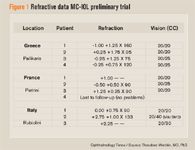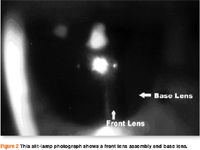Article
Multi-component IOL offers enhanced options, accuracy
The multi-component IOL (PrecisionLens) is a novel, foldable implant technology consisting of three optical elements (two exchangeable) that was created to produce an emmetropic result reliably in all patients who undergo cataract surgery or refractive lens exchange.

Key Points
Charlottesville, VA-The multi-component IOL, or MC-IOL (PrecisionLens), will be the most accurate pseudophakic lens platform on the market for cataract and refractive surgeons, said Theodore Werblin, MD, PhD.

Dr. Werblin is the inventor of the MC-IOL and also is a clinical professor of ophthalmology, University of Virginia, Charlottesville. The MC-IOL represents an optical system that corrects errors in sphere and cylinder. It also can provide multifocality, and it can be manufactured with or without a chromophore. Future iterations will address spherical and higher-order aberrations and possibly provide an intraocular telescope to address the needs of patients who develop age-related macular degeneration later in life.

He compared the MC-IOL with a currently available IOL model that is marketed in two multifocal versions, with and without a chromophore, in power steps of 0.5 D.
"With the marketed multifocal IOL, with or without chromophore, surgeons have about 100 different lenses to choose from," he said. "Considering the same power range, and based on the permutations and combinations of a numerically similar 100-element inventory for [the MC-IOL], there would be 6 million different optical choices for [MC-IOL] implantation in the primary operation.
"Furthermore, since the front two elements can be surgically removed and exchanged, there is the ability to provide an additional 240,000 variations at any time postoperatively," Dr. Werblin added.
In contrast to existing custom-made IOLs, which take months to manufacture and deliver, the MC-IOL is made from prefabricated parts. Therefore, once an order is placed, the MC-IOL system immediately can be assembled and shipped within 24 hours.
When it first becomes available, the number of possible iterations of the MC-IOL will be limited. According to current plans, it eventually will be marketed in a spherical power range from-10.0 to +40.0 D and to correct up to 6.0 D of astigmatism in 0.25-D steps. Adjustment procedures should be able to fine-tune spherical refractive results in a range of ±4.0 D, as well as astigmatic refractive results, he said.
Dr. Werblin began working on his idea for the MC-IOL in the 1990s and the first iteration was made of polymethyl methacrylate (PMMA). The commercial feasibility of the project was limited, however, because foldable technology was taking over the IOL market and the Medicare reimbursement rate for cataract surgery was fixed.
"Although the system was perfected in PMMA, there was no longer an incentive to continue its development in that material. Now that patients can pay out-of-pocket for premium IOLs and the demand for these implants is increasing, there was new justification for creating a foldable version of the MC-IOL," Dr. Werblin said.

Eliminates incisional tactics
"Another benefit of this system is that it eliminates the need for any incisional approaches to correct for pre-existing astigmatism because the optics of the lens take the pre-existing astigmatism and surgically induced astigmatism into account," Dr. Werblin said.
To date, about a dozen patients have undergone implantation of the multi-component IOL in Europe. With the exception of one patient with macular disease whose vision outcome was 20/40, the remaining patients achieved 20/20 or 20/25 vision.
Enhancements for astigmatic and spherical corrections with the MC-IOL exchange procedure are planned for three patients.
The MC-IOL has received the CE mark for sales in Europe and is expected to be commercially available there in 2009.
The final prototype of the MC-IOL and a video demonstration of the surgical procedure will be on view during the annual meeting of the American Academy of Ophthalmology at the Imperial Medical Technologies booth (#945 and #947). Imperial Medical has supported some of the initial work on the device and will be involved in lens assembly and distribution.
For a video demonstration of the surgical lens assembly process, surgeons also can visit the MC-IOL Web site at http://www.emmetropiainc.com/.
Newsletter
Don’t miss out—get Ophthalmology Times updates on the latest clinical advancements and expert interviews, straight to your inbox.




